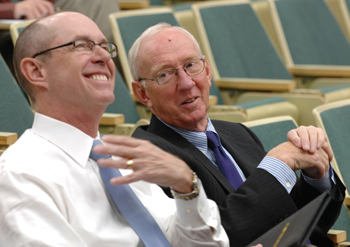
Nobel laureate Bengt Samuelsson, M.D., D.Med.Sc., right, shares a laugh with Larry Marnett, Ph.D., at last week’s lectures. (photo by Neil Brake)
Discovery’s ‘music’ still resonates

Nature's use of a simple molecule — arachidonic acid — is a biological sonata.
“It's a very beautiful system, almost like playing the piano,” Nobel laureate Bengt Samuelsson, M.D., D.Med.Sc., told a Vanderbilt audience last week. “It's a very simple structure in the beginning.”
Yet, through the interplay of enzymes, tissues and receptors, this single note leads to a crescendo of biological actions throughout the body.
A half century after he began his studies of the “arachidonic acid cascade,” and 25 years after he was awarded a Nobel Prize in Physiology or Medicine for his discoveries, Samuelsson is still thrilled by the music.
During two lectures on Oct. 11 — the inaugural John A. and Meredith S. Oates Lectureship in Clinical Pharmacology and the Vanderbilt Discovery Lecture — Samuelsson, professor of Physiological Chemistry at the Karolinska Institute in Sweden, described his pivotal and continuing research.
Arachidonic acid, a polyunsaturated fatty acid, is a major constituent of the cell membrane. Its breakdown products — including the prostaglandins — have powerful physiological effects, including inflammation.
Samuelsson's studies of prostaglandins, which are generated by the action of the cyclooxygenase or COX enzymes on arachidonic acid, led to the discovery of thromboxane.
Produced by the COX-1 enzyme in platelets, thromboxane stimulates platelet aggregation and thrombus (clot) formation.
Sir John Vane, D.Phil., who shared the 1982 Nobel Prize with Samuelsson and his colleague Sune Bergström, M.D., discovered another breakdown product, prostacyclin. It is produced by the COX-2 enzyme in blood vessel walls and inhibits clot formation.
COX-2 inhibitors, developed to relieve the pain and inflammation without causing stomach ulcers, were later found to increase the risk of heart attack because they block production of prostacyclin but not thromboxane.
But that's not the end of the story.
In 1999, Samuelsson and his colleagues identified the human PGE synthase, an enzyme that generates a prostaglandin with inflammatory activity.
“Knocking out” the gene for the enzyme in mice has an anti-inflammatory effect, he said, but does not increase blood clot formation. Blocking the enzyme could lead to a new — and safer — way to treat pain and inflammation.
Samuelsson also discovered the leukotrienes, another family of biologically active molecules produced by the action of lipoxygenase enzymes on arachidonic acid in white blood cells (leukocytes).
Leukotrienes cause constriction of the airways and other symptoms of asthma. Leukotriene receptor antagonists like Accolate are now used routinely to treat the disease.
But again, the story continues.
In 2003, Samuelsson and his colleagues reported that expression of a particular lipoxygenase, 5-LO, was markedly elevated in atherosclerotic lesions — more evidence for the role of inflammation in heart disease.
Research is now under way to determine whether blocking the enzyme may slow the progression of atherosclerosis.
“We don't know where this ends,” Samuelsson said, “but a lot of companies are interested.”
The Oates lectureship is named for Vanderbilt's John Oates, M.D., who is internationally known for his research on prostaglandins and related molecules, and his wife, Meredith.
For a complete schedule of the Discovery Lecture Series and archived video of previous lectures, go to www.mc.vanderbilt.edu/discoveryseries.













